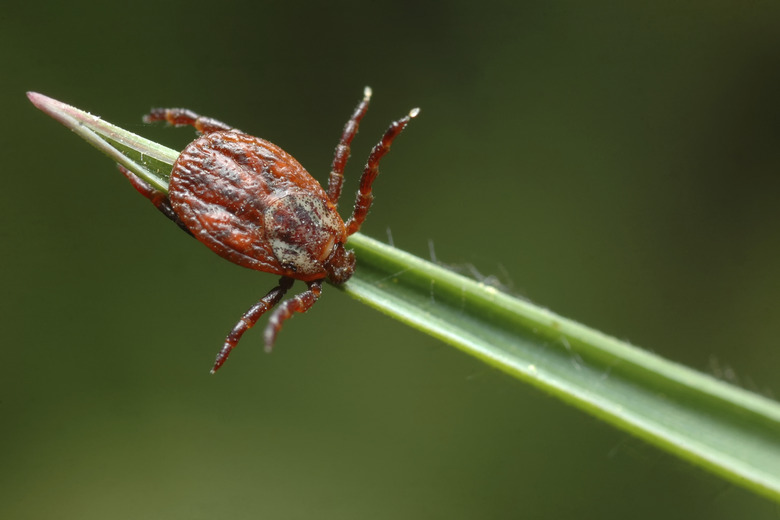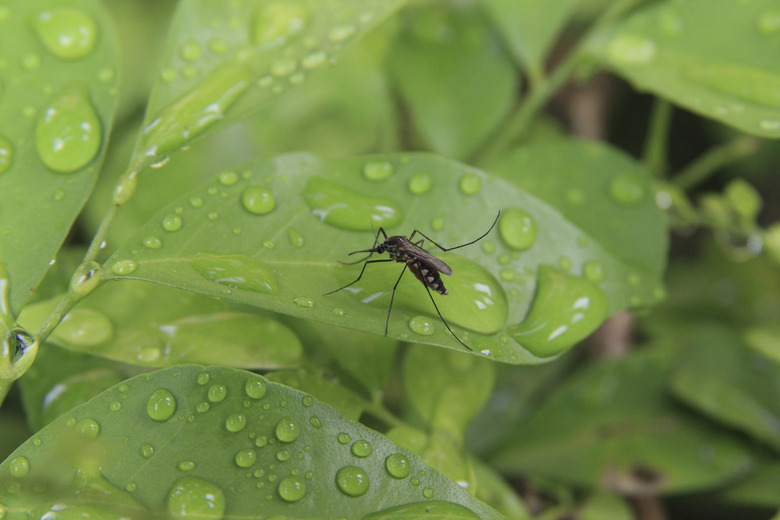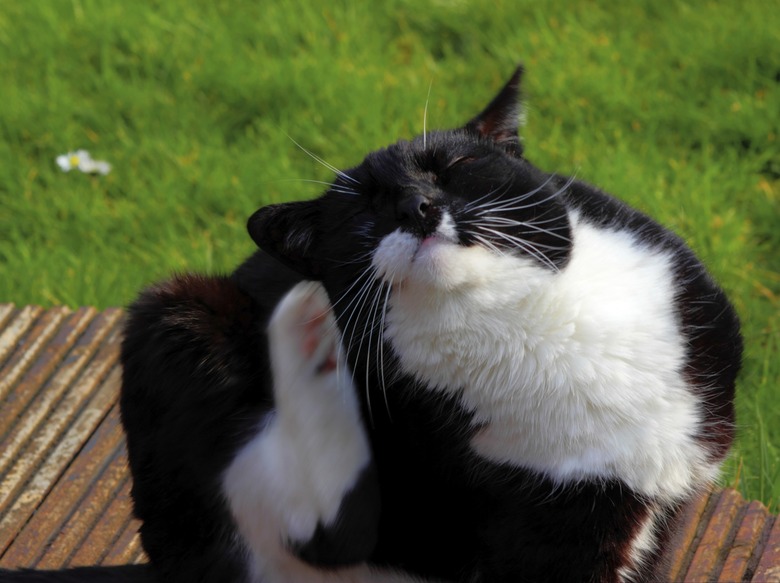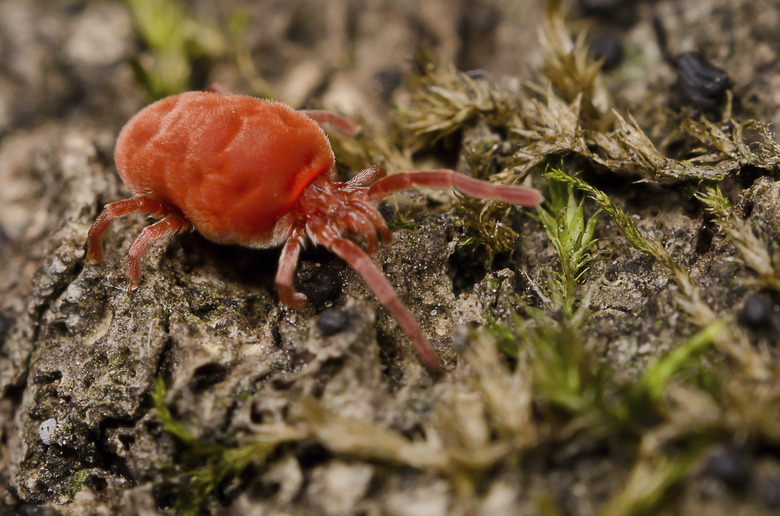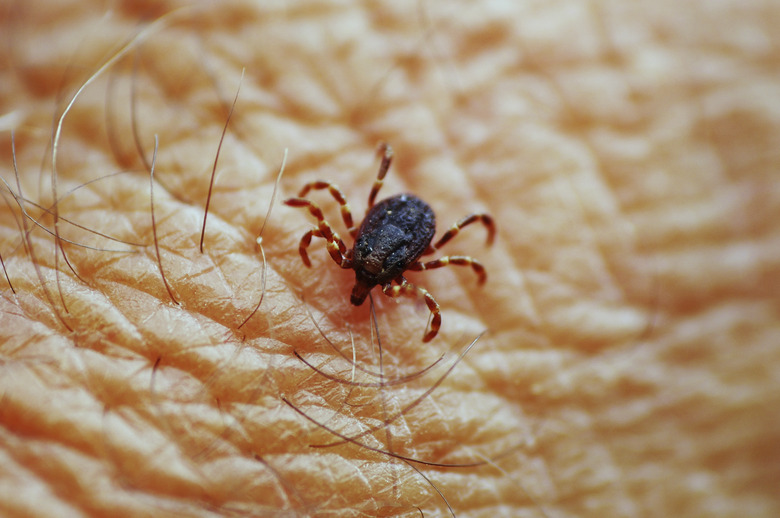Lawn Bugs That Bite
One of the reasons for having a lawn is so you can enjoy using it. The presence of biting bugs definitely cuts down on how much you can relax on the grass and may even affect your maintenance of the lawn. The creatures that bite you aren't necessarily harming your lawn; they're just using it for a resting place, a home or foraging for food. Biting bugs can be insects or insect relatives such as mites and ticks.
Female Mosquitoes
Mosquitoes are the bane of summertime lawn activities. Their immature forms live in nearby bodies of water, even small quantities such as water in a discarded tin can. Adult mosquitoes hide in foliage. One group of species comes out at dusk or dawn to feed and another feeds during the daytime. Female mosquitoes need a blood meal to lay their eggs, and they inject an anticoagulant saliva before withdrawing blood. To find hosts, mosquitoes detect body heat, the increased concentration of carbon dioxide from exhaled air, and body odors, specifically lactic acid. The best protection against mosquito bites is to destroy mosquito breeding habitats before they can lay eggs, to wear protective clothing and using mosquito repellants such as DEET.
- One of the reasons for having a lawn is so you can enjoy using it.
- The best protection against mosquito bites is to destroy mosquito breeding habitats before they can lay eggs, to wear protective clothing and using mosquito repellants such as DEET.
Biting Midges
Sometimes called no-see-ums or punkies, tiny biting flies in the family Ceratopogonidae that are small enough to pass through most window screens sometimes use lawn grasses and nearby vegetation as refuges. Only female midges bite. They have blade-like mouthparts that lacerate the skin so they can suck up blood. They're so small — less than 1/8-inch long — that you can hardly see them. The bites are painful and can result in long-lasting welts and local allergic reactions. Apply DEET to prevent midge bites.
Fleas
Small, wingless, jumping insects, fleas breed in moist environments and feed on household pets as well as humans. Adults have sucking-piercing mouthparts built for taking blood from hosts. Larvae are grub-like creatures that need a week to several months to develop into adults. The adults hide in grasses and other vegetation, waiting for a potential host. They usually bite people on legs and ankles, causing red, circular itchy spots. Control fleas on pets and clean and wash pet bedding and sleeping quarters. Apply insect repellant to prevent flea bites.
- Sometimes called no-see-ums or punkies, tiny biting flies in the family Ceratopogonidae that are small enough to pass through most window screens sometimes use lawn grasses and nearby vegetation as refuges.
- Small, wingless, jumping insects, fleas breed in moist environments and feed on household pets as well as humans.
Chiggers
Chiggers are larval forms of a mite that hide in grass or other vegetation from spring until the fall. They don't suck blood, but rather emit a digestive saliva so they can digest skin cells. They usually attack areas of thin skin around hair follicles. Your body reacts to their saliva, causing a red bump. The chiggers are tiny, red crawling insects that can remain on your skin or clothing to cause another bite, so wash yourself and your clothing with hot, soapy water after chigger exposure. Keeping grass and tall plants mowed short helps prevent chigger infestations. Apply insect repellant such as DEET to socks and pant legs.
- Chiggers are larval forms of a mite that hide in grass or other vegetation from spring until the fall.
- The chiggers are tiny, red crawling insects that can remain on your skin or clothing to cause another bite, so wash yourself and your clothing with hot, soapy water after chigger exposure.
Ticks
Larval and adult ticks need blood to molt and lay eggs. They hide in plants and hook onto passing hosts with their legs. After injecting saliva, they fill with blood and drop back off. They can remain with their mouthparts embedded in the skin for hours. To prevent tick infestations, keep the lawn mowed, remove tall vegetation around the lawn and the house, and put a 3-foot-wide barrier of wood chips or gravel between the yard and forested areas.
References
- University of Georgia Extension: Stinging and Biting Pests
- Maryland Department of Agriculture: Mosquitoes — Host Attractants
- Purdue University: Medical Entomology: Biting Midges
- University of Florida IFAS Extension: Fleas
- Kansas State University Research and Extension: Johnson County: Protect Your Ankles from Chiggers
- Centers for Disease Control and Prevention: Preventing Ticks in the Yard
